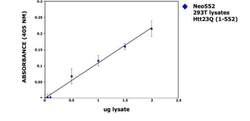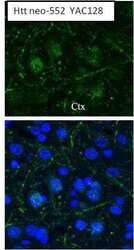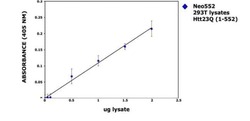Antibody data
- Antibody Data
- Antigen structure
- References [3]
- Comments [0]
- Validations
- ELISA [1]
- Immunocytochemistry [2]
- Immunohistochemistry [1]
- Other assay [1]
Submit
Validation data
Reference
Comment
Report error
- Product number
- PA1-003 - Provider product page

- Provider
- Invitrogen Antibodies
- Product name
- Huntingtin Polyclonal Antibody
- Antibody type
- Polyclonal
- Antigen
- Synthetic peptide
- Description
- Neoepitope antibodies distinguish smaller cleaved fragments or processed forms of proteins versus the intact full-length or precursor by using a designed peptide purification process to maximize immunoreactivity to a specific cleavage site. Human HTT caspase cleavage sites generate fragment-specific forms of the protein. Caspase-3/7 has been shown to generate cleavage sites at animo acids 513 and 552. Caspase-2 cleaves at amino acid 552 and caspase-6 at amino acid 586. Neo-specific antibody PA1-003 recognizes the 552 cleaved fragment without detecting the full-length form.
- Reactivity
- Human, Mouse
- Host
- Rabbit
- Isotype
- IgG
- Vial size
- 100 μL
- Concentration
- 0.4 mg/mL
- Storage
- -20°C
Submitted references Identification and evaluation of small molecule pan-caspase inhibitors in Huntington's disease models.
Specific caspase interactions and amplification are involved in selective neuronal vulnerability in Huntington's disease.
Caspase cleavage of mutant huntingtin precedes neurodegeneration in Huntington's disease.
Leyva MJ, Degiacomo F, Kaltenbach LS, Holcomb J, Zhang N, Gafni J, Park H, Lo DC, Salvesen GS, Ellerby LM, Ellman JA
Chemistry & biology 2010 Nov 24;17(11):1189-200
Chemistry & biology 2010 Nov 24;17(11):1189-200
Specific caspase interactions and amplification are involved in selective neuronal vulnerability in Huntington's disease.
Hermel E, Gafni J, Propp SS, Leavitt BR, Wellington CL, Young JE, Hackam AS, Logvinova AV, Peel AL, Chen SF, Hook V, Singaraja R, Krajewski S, Goldsmith PC, Ellerby HM, Hayden MR, Bredesen DE, Ellerby LM
Cell death and differentiation 2004 Apr;11(4):424-38
Cell death and differentiation 2004 Apr;11(4):424-38
Caspase cleavage of mutant huntingtin precedes neurodegeneration in Huntington's disease.
Wellington CL, Ellerby LM, Gutekunst CA, Rogers D, Warby S, Graham RK, Loubser O, van Raamsdonk J, Singaraja R, Yang YZ, Gafni J, Bredesen D, Hersch SM, Leavitt BR, Roy S, Nicholson DW, Hayden MR
The Journal of neuroscience : the official journal of the Society for Neuroscience 2002 Sep 15;22(18):7862-72
The Journal of neuroscience : the official journal of the Society for Neuroscience 2002 Sep 15;22(18):7862-72
No comments: Submit comment
Supportive validation
- Submitted by
- Invitrogen Antibodies (provider)
- Main image

- Experimental details
- Sandwich ELISA was performed with a monoclonal antibody to Htt and an Htt neo-epitope 552 polyclonal antibody (Product # PA1-003) to determine the antigen concentration of the Htt cleavage products. The curve represents a dose response for neo552 in 293T cells overexpressing the Htt construct.
Supportive validation
- Submitted by
- Invitrogen Antibodies (provider)
- Main image

- Experimental details
- Immunofluorescent analysis of Caspase cleaved Htt (green) in 293T cells transfected with an Htt23Q (left panel) and Htt148Q (right panel) stop constructs ending in amino acid 552. Formalin fixed cells were permeabilized with 0.1% Triton X-100 in TBS for 10 minutes at room temperature and blocked with 5% normal goat serum for 15 minutes at room temperature. Cells were probed with an Htt neo-epitope 552 polyclonal antibody (Product # PA1-003) at a dilution of 1:50 for at least 1 hour at room temperature, washed with PBS, and incubated with goat-anti-rabbit secondary antibody at room temperature. Nuclei (blue) were stained with Hoechst dye.
- Submitted by
- Invitrogen Antibodies (provider)
- Main image

- Experimental details
- Immunofluorescent analysis of Caspase cleaved Htt (green) in 293T cells transfected with an Htt23Q (left panel) and Htt148Q (right panel) stop constructs ending in amino acid 552. Formalin fixed cells were permeabilized with 0.1% Triton X-100 in TBS for 10 minutes at room temperature and blocked with 5% normal goat serum for 15 minutes at room temperature. Cells were probed with an Htt neo-epitope 552 polyclonal antibody (Product # PA1-003) at a dilution of 1:50 for at least 1 hour at room temperature, washed with PBS, and incubated with goat-anti-rabbit secondary antibody at room temperature. Nuclei (blue) were stained with Hoechst dye.
Supportive validation
- Submitted by
- Invitrogen Antibodies (provider)
- Main image

- Experimental details
- Immunohistochemistry was performed on tissues from transgenic HD mice of the YAC128 line. Cortex tissue samples were probed with an Htt neo-epitope 552 polyclonal antibody (Product # PA1-003) at a dilution of 1:50 overnight at 4°C in a humidified chamber. Tissues were washed extensively and endogenous peroxidase activity quenched for 30 minutes at room temperature. Detection was performed using a goat anti-rabbit HRP secondary antibody (green). Tissues were counterstained with nuclei stain (blue) and prepped for mounting.
Supportive validation
- Submitted by
- Invitrogen Antibodies (provider)
- Main image

- Experimental details
- Sandwich ELISA was performed with a monoclonal antibody to Htt and an Htt neo-epitope 552 polyclonal antibody (Product # PA1-003) to determine the antigen concentration of the Htt cleavage products. The curve represents a dose response for neo552 in 293T cells overexpressing the Htt construct.
 Explore
Explore Validate
Validate Learn
Learn Western blot
Western blot ELISA
ELISA